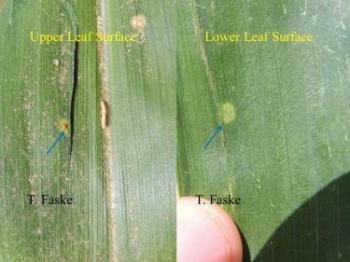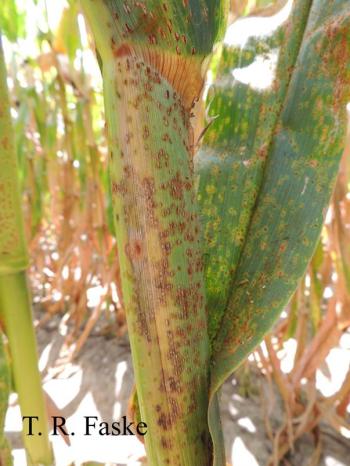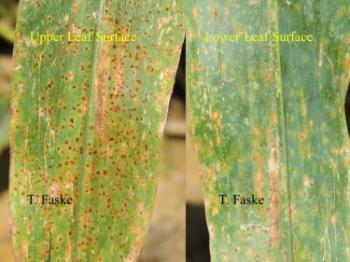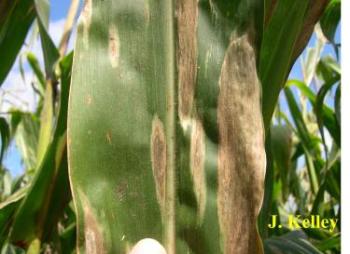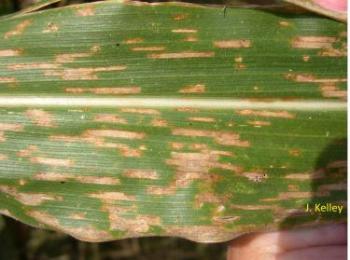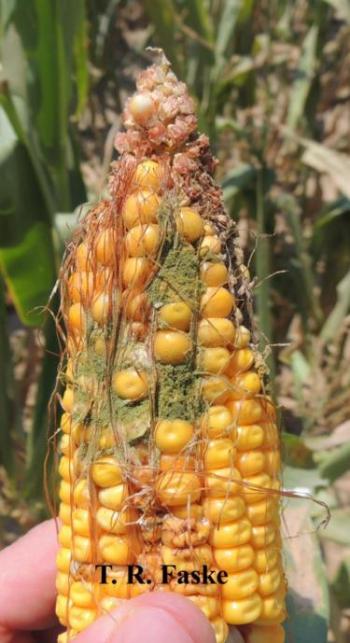Corn Diseases
Seedling Diseases
Corn seeds and seedlings may be attacked by numerous soilborne fungi (e.g., Pythium, Diplodia, Fusarium, Penicillium, etc.) that cause seed rot or seedling blight. Significant stand loss can occur especially
in poorly drained, excessively compacted fields or when cold and/or wet soils conditions
persist for a long time after planting. A soft rotting of stem tissues near the soil,
yellowing, wilting and death of leaves are common symptoms of blighted seedlings.
To manage seedling diseases, plant quality, fungicide-treated seed into warm soil
(consistently above 55°F) with sufficient moisture for rapid seedling emergence.
Foliar Diseases
Southern Rust is one of the most important foliar corn diseases in Arkansas, which is reintroduced each year from southern states. When southern rust arrives late in the growing season on dough or dent growth stages it causes minimal losses. However, the risk of yield loss is much higher when infection occurs at tasseling or silking.
Symptoms: Southern rust is caused by the fungus Puccinia polysora, which only infects corn. Pustules of southern rust are small (0.2 to 2 mm in diam.), circular to oval, and light cinnamon brown to orange (Fig. 1) that frequently form on the upper leaf surface and very infrequently on the lower leaf surface (Fig. 1). Southern rust pustules may occur on leaves, stalks, sheath, and husks (Fig. 2).
Figure 1. Early season infection of Southern rust on upper and lower corn leaf surfaces.
Figure 2. Southern rust on corn sheath and leaf.
Rust spores are windblown from diseased areas progressively northward during the growing season. Typically, early season scouting for rust is easily overlooked by the casual observer because initial infections are typically only one to two pustules per plant (Fig. 1). The absence of sporulation on the lower leaf surface is in an indication of southern rust. In contrast, rust sporulation on the lower leaf surface is frequently associated with common rust, a minor disease. Early season pustule development is most frequently observed in the field at mid canopy level (4 to 5 ft. from ground) along the edge of the field. Free moisture as dew or light rain is necessary for rust spores to germinate and infect. Symptoms appear about 3 to 6 days after infection and by 7 to 10 days the pustules may rupture to expose more rust spores. Thus, new infections can occur very rapidly after the initial infection when conditions favor disease. Conditions that favor disease development consist of high temperatures (80ºF to 90ºF), high relative humidity, and frequent rainfall. Even in hot summer conditions with temperatures above 100ºF pustules continue to sporulate, hence the name southern rust.
Management: Corn hybrids vary in susceptibility to southern rust and the least susceptible hybrid should be planted in areas with a history of early season rust development. Since rust spores are windblown from southern states and initial infection at later stages of corn development is less likely to impact disease, early planted corn may avoid significant disease pressure. Fungicides are effective at suppressing southern rust though there is no economic threshold for a fungicide application. Producers should consider yield potential, hybrid susceptibility, growth stage, and the long range forecast when southern rust threatens. A fungicide application at tasseling or silking when southern rust has have been observed on a susceptible hybrid with good yield potential may be the most beneficial at suppressing disease development; however, additional application may be needed for season long crop protection. Field corn within two weeks from physiological maturity (i.e. black layer) is very unlikely to benefit from a fungicide application.
Common rust has been reported in all corn production regions of the US. Though this rust frequently occurs in Arkansas yield losses are negligible because environmental conditions in the summer are not favorable for common rust.
Symptoms: Common rust is caused by the fungus P. sorghi. As with southern rust, this rust only infects corn and not sorghum as the scientific name suggests. Pustules of common rust are circular to elongate, golden brown to cinnamon brown and found on upper and lower leaf surface (Fig. 3). As the pustule matures, cinnamon brown urediniospores are replaced by golden brown to black teliospores, which causes the pustules to darken to a brownish black.
Figure 3. Common rust pustules on upper and lower corn leaf surfaces.
Rust spores are windblown from tropics and move progressively northward during the growing season. Conditions that favor infection consist of moderate temperature (61ºF to 77ºF) and high relative humidity (>95%). At least 6 hours of free moisture is required for rust spore germination and infection. The latent period is 7 days with optimum conditions for disease development. Common rust is typically found in the lower canopy (1 to 2 ft. from the ground) and younger leaves are more susceptible than fully expanded mature leaves.
Management: In contrast to southern rust, common rust is considered a minor disease in Arkansas and typically requires no management practice. Resistant hybrids are effective and available; however, environmental conditions during the summer are often unfavorable for common rust to be a significant disease issue. Fungicides are effective, but not economically practical.
Northern Corn Leaf Blight (NCLB) commonly occurs in humid climates where corn is grown. As with most foliar diseases timing of infection is critical to yield losses. When disease development occurs before silking yield losses of 50% can occur; however, yield losses are minimal when disease development occurs after dough or dent growth stages.
Symptoms: Large (1 to 6 inches) gray green, cigar-shaped lesions develop on infected corn leaves (Fig. 4). Mature lesions are tan with dark zones of fungal sporulation. Size and shape of lesion may vary with genes for resistance among hybrids. NCLB is caused by a fungus, Exserohilum turcicum, which can infect sorghum, Johnson grass and Sudan grasses. The fungus overwinters on crop residue left on the soil surface. In the spring, conidia are produced that are dispersed by wind to cause the primary infection. Secondary infection occurs from the abundant conidia produced on leaf lesion. New lesions can produce spores within a week, thus new infection can occur quickly. Disease development is favored by moderate temperatures (64ºF to 81ºF) and prolonged periods of leaf wetness provided by heavy dew.
Management: Resistant hybrids are available and the most economical tactic to manage this disease. Four single dominant genes Ht1, Ht2, Ht3, and HtN confer resistance to NCLB. Resistance is expressed as chlorotic lesions that support limited sporulation or long latent period with a few lesions. Crop rotation and tillage practices can hasten the decomposition of corn residue and subsequent survival of pathogen on crop residue. Fungicides can be beneficial when NCLB is observed at late vegetative or early reproductive stages on susceptible hybrids with good yield potential.
Figure 4. Several large lesions caused by northern corn leaf blight.
Gray Leaf Spot is one of the most common foliar diseases of corn. It is most severe where minimum tillage is a common production practice along with warm, humid conditions.
Symptoms: Early season symptoms consist of small necrotic spots sometimes with a chlorotic halo that are difficult to distinguish from other foliar corn diseases. Mature lesions are tan to gray and expand linearly between leaf veins giving a rectangular shape (Fig. 5).
Gray Leaf Spot is caused by the fungus, Cercospora zeae-maydis. The fungus overwinters in crop residue that remains on the soil surface. In the spring, spores are produced that are dispersed by wind and splashing rain onto corn leaves. Disease development is favored by warm (72 to 86° F) humid (high humidity or leaf wetness) conditions.
Management: Resistant hybrids are available and should be considered in minimum tillage systems. In fields with a history of Gray Leaf Spot, conventional tillage practices that promote crop decomposition and one crop rotation is recommended. Foliar fungicides may be economically beneficial on susceptible hybrids to protect high yield potential with prolonged conditions that favor disease development.
Figure 5. Numerous rectangular lesions caused by Gray Leaf Spot.
Southern corn leaf blightt (SCLB) was considered a minor disease with little economic importance until 1970 when this disease reached epidemic proportion. SCLB destroyed 15% of the U.S. corn crop costing an estimated one billion dollars. Later, it was determined a new strain of the fungus (race T) produced a toxin (T-toxin), which was highly aggressive on corn hybrids with the Texas male-sterile cytoplasm (cms-T). In 1970, the majority (~85%) of the U.S. corn hybrids contained cms-T. Today, resistant corn hybrids are used to manage this disease.
Symptoms: Leaf lesions vary in shape, color and size but are generally oval to elongated, tan with yellow green halos to reddish brown borders. Lesions may occur on leaf blades, sheaths, stalks, and husks. The fungus may also attack ears causing a black, felty mold on the kernels.
This disease is caused by the fungus Bipolaris (Helminthosporium) maydis, which infects many other grasses. There are three physiological races of B. maydis; race O, race T, and race C. Only race O and T have been reported in the U.S. The fungus overwinters in soil and crop debris. Conidia (spores) are produced by the pathogen, which are disseminated by wind and splashing rain onto plants. Warm (86 to 90 F) wet weather conditions favor disease development. The disease cycle can be completed within 2 to 3 days with favorable conditions, thus this disease can spread very rapidly.
Management: Resistant hybrids are the most practical and effective management tactic for SCLB. Tillage and one year crop rotation with non-host crops can reduce the overwinter pathogen survival on crop residue. Fungicides are available but rarely economical except in seed corn production.
Anthracnose leaf blight, top dieback, and stalk rot are important diseases of corn. The leaf blight stage can occur on leaves at any growth stage. Anthracnose top dieback and stalk rot are often observed in the field after pollination resulting in premature plant death and subsequently higher yield losses.
Symptoms: Leaf lesions begin as small water soaked lesions that may enlarge up to ½ inch with tan to brown center and yellowish to reddish brown boarders. Lesions may coalesce, killing large leaf areas or entire leaves of susceptible hybrids. Lesion size and can vary depending upon hybrid making diagnosis in the field difficult. The fungal fruiting bodies (acervuli) develop abundantly on dead tissue and can typically be seen with the aid of a hand lens. Dark black spines (setae) can often be observed protruding from these fungal fruiting bodies. Leaf symptoms are common on lower leaves early in the season with no further disease spread until later in the season after tasseling.
Anthracnose top dieback is commonly associated with yellow or dead flag leaf scattered across the field any time after tasseling. Fungal fruiting bodies can be observed on stalk and leaf sheath below the tassel. These blighted top may top-lodge above the ear before harvest. These symptoms can be helpful to differentiate Anthracnose top die back from top dieback caused by environmental stress.
Anthracnose stalk rot is relatively easy to diagnose in the field late in the growing season by shiny black, linear streaks or blotches that appear on the surface of the lower stalk. Stalk pith tissue is often gray to brown in color and the stalk can be easily crushed or lodged with little pressure. Severely diseased stalks are weak and my lodge before harvest. In contrast to top dieback, premature death of the entire plant is an indicator of stalk rot.
Anthracnose of corn is caused by the fungus, Colletotrichum graminicola. The fungus overwinters on crop reside left on the soil surface. In the spring, spores are produced that are dispersed by wind and splashing rain onto leaves causing the primary infection. Anthracnose is favored by warm temperatures, heavy dew and long periods of cloudy, wet weather.
Management: Resistant hybrids are the most economical management practice; however, resistance to leaf blight may not be resistant to anthracnose stalk rot. Also, hybrids with resistance to other stalk rots may not be resistant anthracnose stalk rot. Hybrids with good stalk strength, yield potential, and resistance to appropriate phase of anthracnose should be selected. Since anthracnose overwinters in corn residue complete burial of residue and one-year rotation from corn will significantly lower in-field inoculum. Avoid plant stress by using a balanced soil fertility program and control insect feeding root worms. Finally, if top dieback and/or stalk rot are prevalent harvest should be scheduled earlier to prevent additional losses.
Soilborne Diseases
Charcoal rot is a common stalk rot disease that frequently occurs with prolonged drought conditions. Severe yield losses may result when hot, dry weather persists during and after tasseling.
Symptoms: Infection can occur at any stage from seedlings to plants nearing maturity. Early symptoms of charcoal rot include brown, water-soaked lesions on the root and lower stalk that later turn black. Late in the season, small black microsclerotia can be observed speckled within affected stalks, causing the stalk to appear gray black. Severely diseased stalks are weak and dry rotted causing them to lodge a few inches above the soil line before harvest.
Charcoal rot is caused by a fungus, Macrophomina phaseolina, which has a wide host range that includes many agronomic crops (e.g. soybean and sorghum). The fungus overwinters in the soil as black microsclerotia (0.05 to 0.22 mm) and may infect roots and lower stems at any time during the growing season. Charcoal rot is favored by soil temperatures of 86 to 100 °F with widespread severity during years that are hot and dry.
Management: Charcoal rot losses can be minimized with adequate irrigation during the growing season. Excessive nitrogen rates and low potassium dramatically increase charcoal rot severity. Thus, timely irrigation, combined with a well-balanced fertility program, can effectively reduce charcoal rot. Resistant varieties are not available through planting hybrids with good stalk strength is encouraged to reduce lodging.
Other Stalk Rot diseases of corn may be caused by a variety of soilborne fungi; most important are species of Gibberella, Fusarium, and Pythium. The exact causal organism can be difficult to identify because several fungi may invade tissue once symptoms are obvious. Stalk rots cause yield losses by increasing lodging of the crop or by cutting off the supply of water and nutrients from the roots. Stalk rots are usually increased by drought stress, hail damage, leaf diseases, high stand density, excessive nitrogen fertilization, low soil potassium levels, lack of rotation, possibly minimum tillage and stalk feeding insects.
Symptoms: Stalk rots normally begin soon after pollination and become more severe as the plant matures. Premature death of the entire plant is an indicator of stalk rot. Rotting affects the roots, crown and lower internodes. Various discolorations of the pith, including whitish-pink to salmon, are common as is stalk breakage and premature decline.
Management: Plant strong-stalked hybrids to reduce lodging. Practice balanced fertilization based on recent soil tests and avoid excessive nitrogen. Avoid narrow rows and excessive seeding rates if possible. Control stalk insects and harvest as early as possible, especially when stalk rot is persistent or the field has a history of stalk rot.
Aspergillus Ear Rot and Aflatoxin
The single most serious disease threat to Arkansas corn production is aflatoxin - a chemical contaminant of grain produced by certain Aspergillus fungi. Aspergillus flavus and A. parasiticus are weak and opportunistic plant pathogens that cause Aspergillus ear rot. These fungi are ubiquitous and commonly found in soils across Arkansas. Though Aspergillus ear rot commonly occurs at the tip, infection can occur anywhere on the ear. Yellowish to green spores can be seen with unaided eye at infection points (Fig. 6); however, a lab assays is necessary to quantify the level of aflatoxin contamination. Aflatoxin can be produced by these fungi in the field or during storage. Predisposing factors that contribute to field contamination include; drought conditions from tasseling to grain-fill, high temperatures at flowering, insect damage and nutrient (nitrogen) stress. Aflatoxin is produced when kernel moisture is between 20 to 16%, thus delayed harvest or rain during drying can contribute to higher level of aflatoxin. Similarly, contamination in storage is commonly associated with improper drying and storage conditions. In these situations the kernel moisture level increases and dormant fungi begin to grow and produce aflatoxin. Thus, timely harvest and proper storage conditions are key considerations to minimize aflatoxin contamination.
Figure 6. Aspergillus ear rot of corn.
Aflatoxin levels are regulated by the Food and Drug Administration (FDA) beginning at 20 ppb (parts per billion) for use in food and feed. Thus, corn grain that exceeds 20 ppb is very difficult or impossible to sell or use in current marketing environments. Prevention of this problem is of critical importance each year in the South.
Cultural practices to manage aflatoxin contamination in corn include planting early and maintaining proper irrigation from tasseling through grain fill. Also, maintaining optimum fertility for corn production and utilizing Bt hybrids to manage insect damage. Selection of hybrids adapted to the area as well as those with closed shuck morphology has also minimized contamination. A biological product that contains a non-toxigenic strain of A. flavus (Afla-Guard) has been effective at reducing aflatoxin contamination by 60 to 75% in the field. Green fungal spores can be found in ears of corn in treated fields; however, it is impossible to determine if it is a toxigenic infection without lab analysis. This biological management tactic is probably best suited for field with a history of relatively low levels of aflatoxin rather than a high risk field with a history of high levels of aflatoxin contamination.
Additional Resources
Arkansas Field Crop Weed Control Resources
Corn Diseases and Pest Management
Other links
Texas A&M Plant Disease Handbook – Corn
University of Nebraska – Corn Diseases
Contact:
